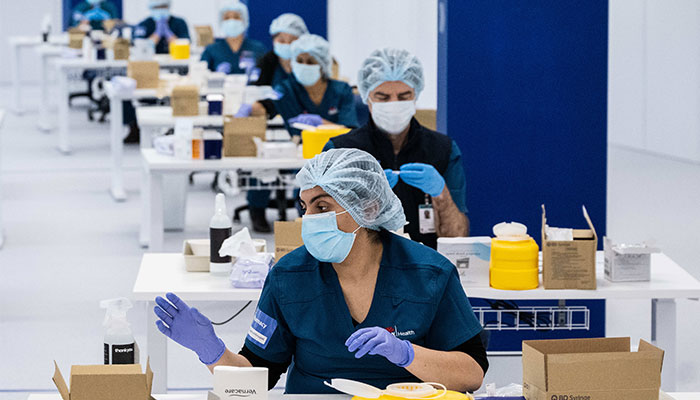In finance and in life, people are often reminded to diversify their portfolio to reduce risk through the adage, “don’t put all your eggs in one basket”.

Rolled out: Staff prepare COVID-19 vaccines at the Olympic Park Vaccination Centre in Sydney.
During the early stages of the COVID-19 vaccine rollout, policymakers should have taken heed of this advice, as it proved almost impossible for them and the general public to differentiate between the few options on the market.
Unfortunately, this lack of distinction around the various COVID-19 vaccines, coupled with a contradictory initial reliance on a single vaccine, blurred the key message around the importance of getting vaccinated, leaving the public in doubt and confused about the merits of receiving the jab.
A recent survey found almost one-third of adult Australians say they are unlikely to get the COVID-19 vaccine in the months ahead.
If we now want to change a strategy from solely relying on one or two vaccines, to a portfolio of vaccines, there are a few issues.
This is despite the fact that the Pfizer and Astra-Zeneca vaccines have both been deemed effective by global authorities to fight the virus.
Some degree of differentiation did exist such as whether they were 'one-jab' or 'two-jab' vaccines, and the temperature at which they needed to be stored.
There is also differentiation in how exactly each vaccine works at a cellular level. Regardless, they all promise to deliver the same benefit to the patient and society at large.
- Hackers could bring down our cities– here's how we stop them
- Parramatta heritage goes online in spectacular 3D
Given the turnaround time to create these vaccines (and the supply risks involved), the vaccine rollout plan should have practised portfolio diversification and risk reduction from the start.
If we now want to change a strategy from solely relying on one or two vaccines, to a portfolio of vaccines, there are a few issues that can impact the responsiveness of supply. This often explains why it is difficult for anyone to chart a new timeline when a sudden change in strategy occurs.
Supply factors not in Australia's favour
The elasticity, or the responsiveness of supply, is about how a product can easily make its way from a producer to the end consumer. This responsiveness depends on a few factors such as the uniqueness of the resources used in the production process, the complexities of the infrastructure involved in the supply chain, the ability to store the product, and the time frame for adjusting the supply.

Production line: The physical rollout of the vaccine, from big pharma to a vaccination hub, requires an intricately co-ordinated supply chain.
In the case of Australia’s vaccine rollout plan, all of these factors have not worked in Australia’s favour, resulting in a relatively ‘inelastic’, and hence, irresponsive supply.
Before a vaccine is considered safe for distribution to the public, billions of dollars are spent on research and development, and the vaccine has to undergo rigorous trials. The resources used in this process are unique, ranging from expert scientists to purpose-built labs.
Once a vaccine is approved for public use, the production process of each vaccine again uses unique resources, ranging from pharmaceutical production plants to testing facilities. A further impact on the responsiveness of supply is that the pharmaceutical industry itself is an oligopoly, where a small number of large firms compete for unique resources such as specialised scientific expertise.
Slowed down by supply chain complexities
The complexities of the infrastructure in the supply chain – both physical and legal – are also not also assisting with an efficient vaccine rollout.
The physical rollout of the vaccine, from big pharma to a vaccination hub, requires an intricately co-ordinated supply chain involving continents, international flights and, upon arriving in Australia, dealing with our federal-versus-state infrastructure.

Extraordinary times: Dr Prashan Karunaratne says typically, a rollout from the conception phase to administering the vaccine would take several years or even decades.
On a global scale, the legal infrastructure also hinders the responsiveness of supply where big pharma and the World Health Organisation are not in agreement when it comes to the enforcement of patent laws.
Ordinarily, patents are mechanisms to encourage risk-taking and innovation in order to invent products for the betterment of society. However, in the case of a pandemic, public health is directly proportional to the uptake of a vaccine.
The supply chain is not as responsive as policymakers and the general public would like it to be for doses to be made and shipped to Australia.
Typically, a rollout from the conception phase to administering the vaccine would usually take several years or even decades. Most, if not all jurisdictions have expedited the process via emergency processes that have aimed to reduce the time lag in this process -- especially when it comes to the time required to test the vaccines.
The supply chain is not as responsive as policymakers and the general public would like it to be for doses to be made and shipped to Australia.
Throughout the entire supply chain, until the vaccine is administered, the vaccine must be stored under certain conditions. Some vaccines require highly specialised freezers that are costly to produce and run, thereby removing these vaccines as a feasible option for some economically developing countries and some parts of Australia.
Even for the vaccines that do not require these specialised freezers, they still require unique storage facilities and procedures, which limit the responsiveness of supply.
Finally, the time frame in consideration has an impact on the responsiveness of supply. The longer the time frame, the more responsive supply can be.
When there is a longer lead time there is more time to: look for unique resources, to find substitutes for these resources, to co-ordinate infrastructure, to allow patents to expire, and essentially more time to navigate the intricacies of the supply chain -- from conception to administering the vaccine. Combined, all of which increases the responsiveness of supply and reduces the overall risk of a vaccine rollout.
Dr Prashan Karunaratne is a Senior Lecturer in the Department of Actuarial Studies and Business Analytics at the Macquarie Business School, and the Course Director for the Bachelor of Commerce.



